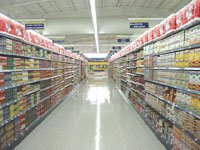Low carb ways to stand out at trade shows

Imagine you are a newly launched box of cereal, made from whole grains and fortified to the rim with vitamins, iron and protein. You are low in sodium, low in sugar, low in carbs, yet very high in taste. In fact, no other cereal offers quite the same healthy mix you do to kick-start the morning. Now you’re ready to go big-time. You have negotiated your spot in a mile-long aisle at one of the nation’s best-known supermarket chains. Soon you’ll be rubbing elbows with the likes of Corn Flakes, Shreddies and Honey Nut Cheerios – industry heavyweights that aren’t exactly dipping into their lucky charms for fear of losing ground to you. Oh, they have seen your type before a fresh new kid-on-the-block with promises of milky grandeur only to find out that shoppers are just passing by without showing a single ounce of interest. The reason? The new kid didn’t know how to work the aisle to call attention to his great tasting granola. Now they expect you to follow a similar fate. What will you do differently?
Companies preparing for a trade show find themselves asking the same question. How can they stand out and attract interest amongst the hundreds of exhibitors and competitors occupying the same real estate? The answer lies in four areas:
1. Pre-show planning and promotion
2. Exhibit design and collateral material
3. At-show boothmanship
4. Post-show follow up
Pre-Show Planning and Promotion
Preparation and proper planning is the blueprint to trade show success. Without it, you can expect the three d’s: disappointment (in your results), disinterest (in working the show) and disservice (to yourself). Once you have established your objective, prepared a budget and chosen a show, decide how you are going to drive traffic to your booth. Pre-show promotion techniques such as direct mail, targeted faxes and emails, the Internet, sponsorship, targeted advertising, and press releases are popular mediums used to let prospects and clients know about your show participation. Recent studies show that most attendees, 50 to 75%, pre-plan which exhibits they are going to visit at a show. In effect, pre-show promotion can greatly increase the number of qualified visitors to your booth by generating interest before the show even begins.
Exhibit Design and Collateral Material
Next comes the all-important, but often ignored, area of exhibit design. As the box of cereal sits anxiously awaiting the attention of a shopper, so does an exhibitor without a powerful backdrop to stop attendees in their tracks. At this stage, a well-designed exhibit that delivers your message and creates a memorable impression is required. If you can’t stop them, you can’t qualify them. And all the money you spent on booth space, staff, travel expenses and accommodations goes out the door, leaving you withnothing to show for it. About five seconds is the average time it takes for an attendee to pass by a ten-foot booth space. This doesn’t give you much time to work with. Not only that, consider all the visual distractions around you: crowds, seminars, product demos, entertainment. There are enough things happening at a trade show to overshadow your presence on the show floor.
At-Show Boothmanship
Learning the art of engaging and disengaging attendees can help you manage your time wisely on the show floor. With so many potential customers floating around, you don’t have time to waste attending to “looky-loos” or “chatterboxes”. Instead, qualify attendees with a few thoughtful questions to help you determine if they would be a potential customer for your products and/or services. If you decide they are, begin to qualify their interest further, listening attentively and recording the information on a lead sheet. Ensure you record a rating of some sort to indicate if the lead is “hot”, “warm” or “long-term”. This will help you prioritize your follow up calls after the show. In general, you shouldn’t spend more than five minutes with a qualified attendee – you may end up ignoring other potential prospects in your booth. If you feel you need to spend more time with a prospect, you can either agree to meet them at another location for coffee to further discuss their needs. Or, if you have a meeting area designed into your exhibit, you can continue in there. Just make sure there is enough staff to cover your area and engage attendees.
Post-Show Follow Up
Once the show is over, collect your leads, prioritize them according to the assigned rating and store them in a safe place for immediate follow up when you return back to the office. It is strongly suggested you make one initial contact with your leads within two working days (and no more than five) after a show. This could be accomplished by a simple email (if provided by the attendee) or postcard. In it, you can thank them for visiting your booth and let them know your next action i.e. you will be mailing them a complete brochure package and then following up with a phone call. Effective post-show follow up can mean the difference between a warm lead or a lucrative sale.



2 comments:
Rajan,
A fellow Vancouverite (I am Coquitlam but close enough)I like your content. I found you through your comments on Duct Tape Marketing which is another great resource. Nice to see you blogging... I am fairly new to it and write when I can... family takes up much of my time.
I understand. Thank you for your comments and feel free to add your insight and experience.
Post a Comment